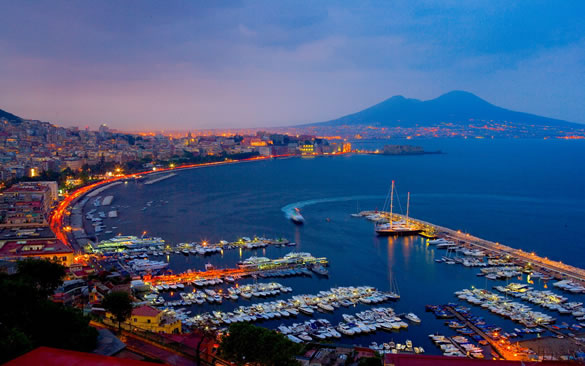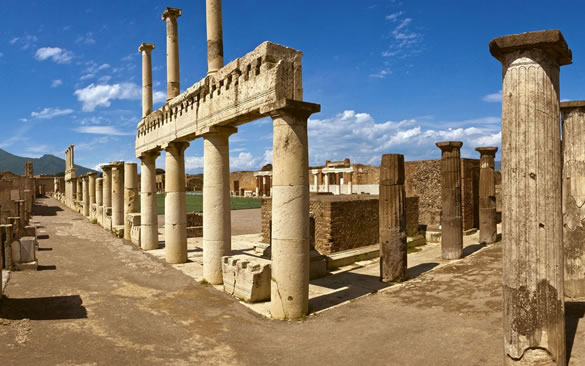
Pompeii was founded in the second half of the VIIth century B.C. by the local population of the Oskens with the purpose of developping sea trade between the Greeks and the natives. It was then turned into a Roman colony in the first century B.C.
An overview of the city in the last decades of its life before the 79 A.D. eruption of Vesuvius, would offer a picture of roads, inns, taverns, brothels in full activity, walls covered with election slogans in favour of this or that candidate, graffiti with names, love messages everywhere.
The districts that still have to be excavated in the north-eastern area may hold some more unexpected surprises, but we can say that the idea of daily life in Pompeii, thanks also to stratigraphic research, has already been quite clearly defined.
Mt. Vesuvius is the best known volcano on Earth; it dominates the Bay of Naples with its characteristic cone. It is a typical example of a volcano in a volcano made by an outer broken cone, Mt. Somma (1133 metres), in which there is a younger cone, Mt. Vesuvius (1281 metres), divided from Mt. Somma by the Valley of the Giant, a part of the ancient caldera where in a later period, perhaps during the 79 A.D. eruption, the Gran Cono (Great Cone) or Mt. Vesuvius arose.
Proceeding along the rim of the crater, during days with good visibility, it is possible to see the entire gulf of Naples.
In 1995 Mount Vesuvius became a National Park, thank to its peculiar flora and fauna, and from the 2005 it is also a museum under the open sky, because its roads house 10 colossal sculptures. The permanent exhibition is called Creator Vesevo.
Herculaneum was a greek city founded around the VIth century B.C. Towards the end of the first century B.C. the town become a resort center for the Roman aristocracy. Herculaneum seems to be more elegant and refined than Pompeii thank to its original architecture and ornaments, as well as to its natural position overlookig the bay of Naples. During the eruption of mount Vesuvius in 79 A.D. Herculaneum was buried by a torrent of mud flooding down from the slopes of the volcano. It solidified and became tufalike, so that it was for centuries the best possible defence against the atmospheric agents.
Excavations began in 1709, while from 1738 to 1765 systematic explorations were financed by the king of Naples Charles III of Bourbons.
Book with our local GTA guide your excursion!
We offer discounts on rates depending on the period, the number of passengers and the number of services requested.
Each tour can be combined as desired, always contacting us via the form.
Duration:
8 Hours about
Suitable for families:
Yes
Suitable for the disabled:
No
Meeting place:
To be defined
Skip the line:
No
Language:
Italiano, English, Deutsch
Type Guide:
More info:
We recommend comfortable shoes; within the site smoking is prohibited; large backpacks cannot be introduced. A cloakroom service is available at the entrance.

